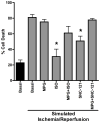Reactive oxygen species trigger ischemic and pharmacological postconditioning: in vivo and in vitro characterization
- PMID: 17915258
- PMCID: PMC2080844
- DOI: 10.1016/j.lfs.2007.08.031
Reactive oxygen species trigger ischemic and pharmacological postconditioning: in vivo and in vitro characterization
Abstract
Reactive oxygen species (ROS) generated by ischemic and pharmacological preconditioning are known to act as triggers of cardiac protection; however, the involvement of ROS in ischemic and pharmacological postconditioning (PostC) in vivo and in vitro is unknown. We tested the hypothesis that ROS are involved in PostC in the mouse heart in vivo and in the isolated adult cardiac myocyte (ACM). Mice were subjected to 30 min coronary artery occlusion followed by 2 h of reperfusion with or without ischemic or pharmacologic PostC (three cycles of 20 s reperfusion/ischemia; 1.4% isoflurane; 10 mg/kg SNC-121). Additional groups were treated with 2-mercaptopropionyl glycine (MPG), a ROS scavenger, 10 min before or after the PostC stimuli. Ischemia-, isoflurane-, and SNC-121- induced PostC reduced infarct size (24.1+/-3.2, 15.7+/-2.6, 24.9+/-2.6%, p<0.05, respectively) compared to the control group (43.4+/-3.3%). These cardiac protective effects were abolished by MPG when administered before (40.0+/-3.6, 39.3+/-3.1, 38.5+/-1.6%, respectively), but not after the PostC stimuli (26.6+/-2.3, 17.0+/-2.2, 23.9+/-1.7%, respectively). Additionally, ACM were subjected to a simulated ischemia/reperfusion protocol with isoflurane and SNC PostC. Isoflurane- and SNC-induced PostC in vitro were abolished by prior treatment with MPG. These data indicate that ROS signaling is an essential trigger of ischemic and pharmacological PostC and this is occurring at the level of the cardiac myocyte.
Figures



References
-
- Argaud L, Gateau-Roesch O, Raisky O, Loufouat J, Robert D, Ovize M. Postconditioning inhibits mitochondrial permeability transition. Circulation. 2005;111(2):194–197. - PubMed
-
- Baines CP, Goto M, Downey JM. Oxygen radicals released during ischemic preconditioning contribute to cardioprotection in the rabbit myocardium. Journal of Molecular Cellular Cardiology. 1997;29(1):207–216. - PubMed
-
- Becker LB. New concepts in reactive oxygen species and cardiovascular reperfusion physiology. Cardiovascular Research. 2004;61(3):461–470. - PubMed
-
- Bolli R, Jeroudi MO, Patel BS, Aruoma OI, Halliwell B, Lai EK, McCay PB. Marked reduction of free radical generation and contractile dysfunction by antioxidant therapy begun at the time of reperfusion. Evidence that myocardial “Stunning” Is a manifestation of reperfusion injury. Circulation Research. 1989;65(3):607–622. - PubMed
Publication types
MeSH terms
Substances
Grants and funding
LinkOut - more resources
Full Text Sources
Medical

